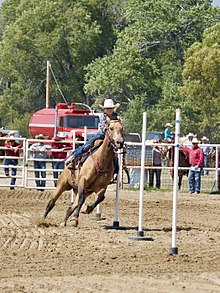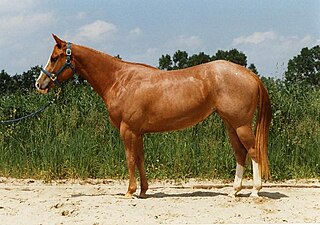
The American Quarter Horse, or Quarter Horse, is an American breed of horse that excels at sprinting short distances. Its name is derived from its ability to outrun other horse breeds in races of 1⁄4 mi (0.40 km) or less; some have been clocked at speeds up to 44 mph (71 km/h). The development of the Quarter Horse traces to the 1600s.

The Nez Perce are an Indigenous people of the Plateau who still live on a fraction of the lands on the southeastern Columbia River Plateau in the Pacific Northwest. This region has been occupied for at least 11,500 years.

Equestrianism, commonly known as horse riding or horseback riding, includes the disciplines of riding, driving, and vaulting. This broad description includes the use of horses for practical working purposes, transportation, recreational activities, artistic or cultural exercises, and competitive sport.

Rodeo is a competitive equestrian sport that arose out of the working practices of cattle herding in Spain and Mexico, expanding throughout the Americas and to other nations. It was originally based on the skills required of the working vaqueros and later, cowboys, in what today is the western United States, western Canada, and northern Mexico. Today, it is a sporting event that involves horses and other livestock, designed to test the skill and speed of the cowboys and cowgirls. American-style professional rodeos generally comprise the following events: tie-down roping, team roping, steer wrestling, Steer roping, saddle bronc riding, bareback bronc riding, bull riding and barrel racing. The events are divided into two basic categories: the rough stock events and the timed events. Depending on sanctioning organization and region, other events such as breakaway roping, goat tying, and pole bending may also be a part of some rodeos. The "world's first public cowboy contest" was held on July 4, 1883, in Pecos, Texas, between cattle driver Trav Windham and roper Morg Livingston.
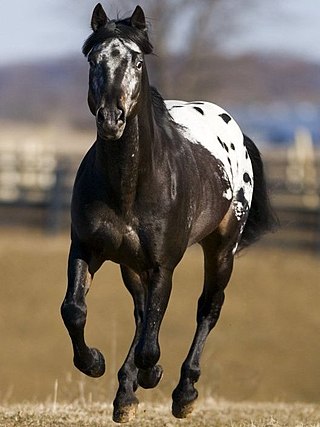
The Appaloosa is an American horse breed best known for its colorful spotted coat pattern. There is a wide range of body types within the breed, stemming from the influence of multiple breeds of horses throughout its history. Each horse's color pattern is genetically the result of various spotting patterns overlaid on top of one of several recognized base coat colors. The color pattern of the Appaloosa is of interest to those who study equine coat color genetics, as it and several other physical characteristics are linked to the leopard complex mutation (LP). Appaloosas are prone to develop equine recurrent uveitis and congenital stationary night blindness; the latter has been linked to the leopard complex.

Barrel racing is a rodeo event in which a horse and rider attempt to run a cloverleaf pattern around preset barrels in the fastest time. In collegiate and professional ranks, it is usually a women's event, though both sexes compete at amateur and youth levels. It requires a combination of the horse's athletic ability and the horsemanship skills of a rider in order to safely and successfully maneuver the horse around three barrels placed in a triangle pattern within a large arena.

The Nez Perce War was an armed conflict in 1877 in the Western United States that pitted several bands of the Nez Perce tribe of Native Americans and their allies, a small band of the Palouse tribe led by Red Echo (Hahtalekin) and Bald Head, against the United States Army. Fought between June and October, the conflict stemmed from the refusal of several bands of the Nez Perce, dubbed "non-treaty Indians," to give up their ancestral lands in the Pacific Northwest and move to an Indian reservation in Idaho Territory. This forced removal was in violation of the 1855 Treaty of Walla Walla, which granted the tribe 7.5 million acres of their ancestral lands and the right to hunt and fish on lands ceded to the U.S. government.

The Nez Perce Horse is a spotted horse breed of the Nez Perce Tribe of Idaho. The Nez Perce Horse Registry (NPHR) program began in 1995 in Lapwai, Idaho and is based on cross-breeding the old-line Appaloosa horses with an ancient Central Asian breed called Akhal-Teke.

Rodeos have long been a popular competitor and spectator sport in Australia, but were not run on an organised basis until the 1880s.
The Appaloosa Horse Club, located in Moscow, Idaho, is dedicated to preserving and promoting the Appaloosa breed. The state of Idaho adopted the Appaloosa as its state horse in 1975. More than 630,000 Appaloosas have been registered with the Appaloosa Horse Club since its founding in 1938. The Appaloosa Horse Club is an international breed registry which records and preserves the breeds' heritage and history. The club is one of the top international equine breed registries, and is dedicated to preserving, promoting, and enhancing the Appaloosa breed.
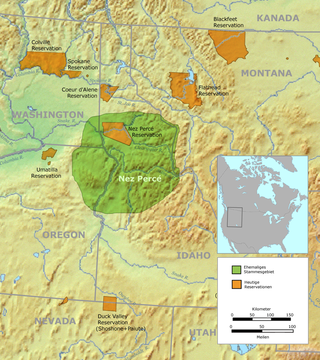
The Battle of White Bird Canyon was fought on June 17, 1877, in Idaho Territory. White Bird Canyon was the opening battle of the Nez Perce War between the Nez Perce Indians and the United States. The battle was a significant defeat of the U.S. Army. It took place in the western part of present-day Idaho County, southwest of the city of Grangeville.

Gymkhana is an equestrian event consisting of speed pattern racing and timed games for riders on horses. These events often emphasize children's participation and may be organized by a recognized Pony Club or a 4-H club. In parts of the western United States, this type of competition is usually called an "O-Mok-See" competition, a term derived from a Native American phrase said to mean "games on horseback". Very small events with little or no prize money, designed for beginners or riders at a local level, are sometimes called playdays. "Gymkhana" is the word used in most of the rest of the English-speaking world, including the United Kingdom and both the East Coast and the West Coast of the United States.
Zippo Pine Bar (1969-1998) is the leading Western Pleasure sire of Quarter Horses.

Jackson Sundown, born Waaya-Tonah-Toesits-Kahn, was a Native American rodeo rider who has become a folk-hero for his mythic performance in the 1916 Pendleton Round-Up, largely popularized by Ken Kesey's novel The Last Go 'Round.

The American Quarter Horse Association (AQHA), based in Amarillo, Texas, is an international organization dedicated to the preservation, improvement and record-keeping of the American Quarter Horse. The association sanctions many competitive events and maintains the official registry. The organization also houses the American Quarter Horse Hall of Fame and Museum and sponsors educational programs. The organization was founded in 1940 in Fort Worth, Texas, and now has nearly 234,627 members, over 32,000 of whom are international.
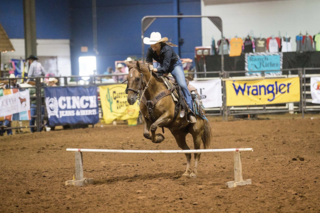
Trail Course is a rodeo event in which a horse and rider attempt to complete a series of obstacles in the fastest time. It combines the horse's athletic ability and the horsemanship skills of a rider in order to safely and successfully maneuver a horse through a series of five obstacles. The rider must remain mounted the entire time. It is similar to Trail competition at horse shows, but with emphasis on speed rather than style.
Mary Burger is an American professional rodeo cowgirl who specializes in barrel racing. She has won two Women’s Professional Rodeo Association (WPRA) barrel racing world championships in 2006 and 2016. Burger was 68 years old when she won the championship in 2016, setting a new record for oldest professional rodeo world champion in any rodeo event, male or female. She broke the existing record set by Ike Rude of 59 years old in steer roping set back in 1953. She also broke the record set by Mary Walker in 2012 at 53 years old. Also In 2016, she became the third WPRA barrel racer to wear the No. 1 back number at the National Finals Rodeo (NFR). She set a new record for season earnings, and she set a new record by becoming the oldest WPRA qualifier to the NFR at 68 years old. Her horses, Mo and Fred, whom she used to win her titles with, she trained in barrel racing herself. In 2017, she was inducted into the National Cowgirl Museum and Hall of Fame.
The Chief Joseph Trail Ride is an annual horse trail ride that follows the route the Nimiipuu took during the Nez Perce War in 1877. The trail in its entirety is 1,300 miles long, separated into thirteen separate rides, which take place sequentially. The ride is on a 13-year cycle. The trail ride was started in 1965 by the Appaloosa Horse Club.
Apache Double was a champion Appaloosa racehorse and stallion in the Appaloosa Horse Club. Two years after his death, in 2001, he was inducted into the ApHc Hall Of Fame for his contributions on the racetrack and his influence as a sire.
